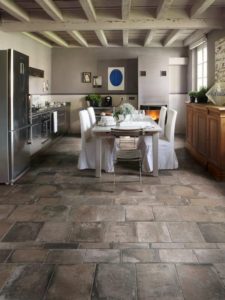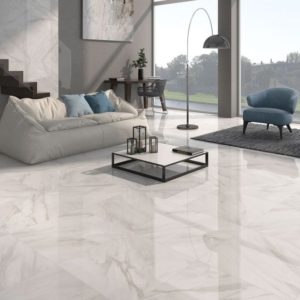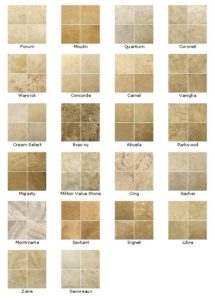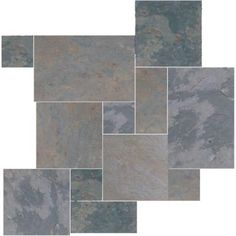The versatility and great look of stone has kept it in the forefront of custom home floor coverings for generations. Americans are obsessed with no cracks, etc., but note the timeless old world charm of stone in Europe and the overall look and warmth with or without slight imperfections. The beauty of natural materials is the diversity from piece to piece and quarry to quarry.
 What is the difference between contemporary and old world looks? Usually the amount of sheen from the finish; honed for old world and polished for contemporary. Depending on the space the stone can either be laid square with the room, which is more common, or diagonally, which is more interesting and costly (more waste). In small spaces the square is usually better; in larger spaces the diagonal is usually better. Currently rectangular shapes are trending (typically laid square with the room) and large format options. The prep and products used for installation are critical as the surface needs to be smooth and flat. Use installers recommended by suppliers to avoid costly tear outs and breakage.
What is the difference between contemporary and old world looks? Usually the amount of sheen from the finish; honed for old world and polished for contemporary. Depending on the space the stone can either be laid square with the room, which is more common, or diagonally, which is more interesting and costly (more waste). In small spaces the square is usually better; in larger spaces the diagonal is usually better. Currently rectangular shapes are trending (typically laid square with the room) and large format options. The prep and products used for installation are critical as the surface needs to be smooth and flat. Use installers recommended by suppliers to avoid costly tear outs and breakage.
Stone can be tumbled, flamed, cross-cut or bush hammered to appear old. Avoid filled Travertine in steam showers as the fill will loosen. A stone base in areas with stone floors looks great and is very functional. It does not need to be filled stone. This base can also be recessed into the drywall.
With marble, travertine or other stones additional colors can be used for dots, contrast and detailing.  Marble is currently widely used, especially for baths. Whatever the choice it is the starting point for colorization.
Marble is currently widely used, especially for baths. Whatever the choice it is the starting point for colorization.
Typical sizing is
18” x 18” or 24” x 24” plus rectangular shapes.
Ashlar Limestone offers some lighter and grayer tones. Quartzite is very durable.
Glass, tiles, river rock pebbles and marble mosaics can add interest and diversity.
Travertine is often used as decking material and is cooler than concrete. Pavers and pool coping may be precut. The most popular materials will have the most options.
Creme of Marfil, Calcutta gold, and grayer choices are plentiful. Check to see what trim or precut options are available to complete the entire space.
Tile sizes of 24” and larger have become the norm along with rectangular options.
 Grout-typically it is matching the material to give the most spacious look. A contrast color will make each tile show more. Mexican tile has grey grout. The installer should be using C-Cure or a quality grout.
Grout-typically it is matching the material to give the most spacious look. A contrast color will make each tile show more. Mexican tile has grey grout. The installer should be using C-Cure or a quality grout.
The above materials require sealing and periodic resealing depending on use. Heavy use may require yearly maintenance. Light use may require every few years. We had Travertine in our last home for 13 years and resealed it once after the original coating.
If you want to inset contrasting tiles into a larger piece, consider the sizing of the inset for enough border space. It may be impossible to cut without breaking the larger piece.
Slate typically has a gray-base tone, and even though it may slough for a few months, the texture is great. It is more rustic than Travertine and less rustic than Flagstone.
Flagstone (Slate/sandstone) in oak, red or pink tones add texture for more rustic interiors and can be installed with random size pieces or can be cut into a pattern. Typically the installers are recommended by the companies that sell the product as the random cutting and placement are not the same as uniform tile. It would be an expensive error to cut costs here and end up with unevenness, lack of flow with cut pieces or inferior grout joints. Flagstone is great for exterior use as well.
Consider the outdoor spaces and a look of continuity in the material you use inside, especially if the two adjoin.
TILE INFO
Porcelain tile with a wood look is the in material for homes that are not in the luxury range. The material is durable and is replicating wood more and more, but it does not have the warmth of wood. However, for families and dogs it is durable and available in a wide range of colors. We recently combined real wood throughout the master and a great match in porcelain cut into 2x2's for the open shower floor. Also, interior wood running to porcelain patios gives a continuous visual. These options include plank shapes.
12x24" options are popular in both real stone and porcelain, as well as 24"x24" and 36"x36". The rectangular shapes can be installed staggered or straight, herringbone, offset, diagonally and offset with additional tiles added in other patterns. Gray tones are currently very popular. These tones will still work with granites, marbles and quartz products.
Porcelain tiles are available that look like Travertine, but most custom homes have real stone.  The advantage of porcelain is that it does not need additional maintenance. It’s a good option for secondary baths. A typical shower floor is 1”x 1” or 2” x 2” for traction but be sure to check coefficient of friction and grout joint size. Honed or tumbled stones may be slightly more slip resistant if you are using real stone.
The advantage of porcelain is that it does not need additional maintenance. It’s a good option for secondary baths. A typical shower floor is 1”x 1” or 2” x 2” for traction but be sure to check coefficient of friction and grout joint size. Honed or tumbled stones may be slightly more slip resistant if you are using real stone.
Limestone or Porcelain is suggested for a contemporary look. Porcelain is fired at a higher temperature than regular tiles giving it improved qualities.
Terrazzo is trending and a choice for a mid century look. Frank Lloyd Wright used it in the Guggenheim in 1959 and it still looks good! It can also be used both in and out for a unified look. Poured in place, seamless, easy to maintain-it can last 50-100 years!
In the Southwest, we still use Mexican tile for its warmth, if the style of the home warrants, but more often wood is used inside and unfinished tile is used on patios. Mexican tile inside does need regular resealing.
![]()
There is more inspiration and information on my Pinterest boards!
Stone, Tile Concrete Finishes Tile Details
![]() Tip: The most interesting pots for plants are in terra cotta or the more expensive Italian pots. If your look is conducive to pots they look best on an equally dark patio material. Concrete pots and glazed pots will last longer than clay pots so coordinate the exterior look for the overall style you are trying to achieve.
Tip: The most interesting pots for plants are in terra cotta or the more expensive Italian pots. If your look is conducive to pots they look best on an equally dark patio material. Concrete pots and glazed pots will last longer than clay pots so coordinate the exterior look for the overall style you are trying to achieve.
![]() Tip: K 15 by Ardex is a cement-based self-leveling floor treatment and pigments can be added.
Tip: K 15 by Ardex is a cement-based self-leveling floor treatment and pigments can be added.
